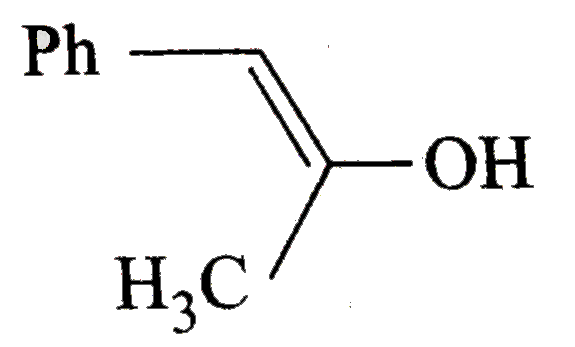Ph-C≡C - CH3Hg2+/H+−−−−−−→A




The correct Answer is:A
To solve the problem, we need to analyze the reaction of the given alkyne (Ph-C≡C-CH₃) with mercuric ion (Hg²⁺) in an acidic medium (H⁺). The process involves hydrolysis, which leads to the formation of a carbonyl compound. Let's break down the steps:
1. Identify the Reactant:
The given alkyne is phenylacetylene, represented as Ph-C≡C-CH₃. This molecule contains a phenyl group (Ph) and a terminal alkyne.
2. Reaction with Mercuric Ion:
The alkyne reacts with mercuric ion (Hg²⁺) in the presence of an acid (H⁺). The reaction involves the formation of a mercuric alkyne complex. The triple bond (C≡C) will coordinate with the Hg²⁺ ion.
3. Formation of Enol:
After the coordination, the next step involves hydrolysis. Water (H₂O) attacks the carbon atom that is bonded to the mercuric ion, leading to the formation of an enol intermediate. The structure at this stage can be represented as:
- Ph-C(OH)=C(Hg)
4. Tautomerization to Ketone:
The enol form is not stable and undergoes tautomerization to form a ketone. In this case, the hydrogen atom from the hydroxyl group (OH) is transferred to the adjacent carbon atom, resulting in the formation of a carbonyl group (C=O). The final product after tautomerization will be:
- Ph-C(=O)-CH₃ (which is acetophenone)
5. Final Product:
The final product of the reaction is acetophenone (Ph-C(=O)-CH₃).
Summary of the Reaction:
Ph-C≡C-CH₃ + Hg²⁺ + H⁺ → Ph-C(=O)-CH₃ (Acetophenone)
The given alkyne is phenylacetylene, represented as Ph-C≡C-CH₃. This molecule contains a phenyl group (Ph) and a terminal alkyne.
The alkyne reacts with mercuric ion (Hg²⁺) in the presence of an acid (H⁺). The reaction involves the formation of a mercuric alkyne complex. The triple bond (C≡C) will coordinate with the Hg²⁺ ion.
After the coordination, the next step involves hydrolysis. Water (H₂O) attacks the carbon atom that is bonded to the mercuric ion, leading to the formation of an enol intermediate. The structure at this stage can be represented as:
- Ph-C(OH)=C(Hg)
The enol form is not stable and undergoes tautomerization to form a ketone. In this case, the hydrogen atom from the hydroxyl group (OH) is transferred to the adjacent carbon atom, resulting in the formation of a carbonyl group (C=O). The final product after tautomerization will be:
- Ph-C(=O)-CH₃ (which is acetophenone)
The final product of the reaction is acetophenone (Ph-C(=O)-CH₃).
Ph-C≡C-CH₃ + Hg²⁺ + H⁺ → Ph-C(=O)-CH₃ (Acetophenone)
Topper's Solved these Questions
- CARBONL COMPOUNDSBook:MOTIONChapter:CARBONL COMPOUNDSExercise:EXERCISE - 4 LEVEL -I
Explore 6 Videos
- BIOMOLECULES & POLYMERSBook:MOTIONChapter:BIOMOLECULES & POLYMERSExercise:EXERCISE - 4 (LEVEL II)
Explore 17 Videos
- CARBOXYLIC ACIDBook:MOTIONChapter:CARBOXYLIC ACIDExercise:Exercise - 4 (LEVEL - 2 )
Explore 22 Videos
Similar Questions
Knowledge Check
Ph−C≡C−CH3Hg2+/H+−−−−−−→A, A is
A B
B C
C D
D
Ph−C≡C−CH3Hg2+/H+−−−−−−→A, A is
A B
B C
C D
D
Ph−C≡C−CH3Hg2+/H+−−−−−−→A,A is :
A B
B C
C D
D
Ph−C≡C−CH3Hg2+/H+−−−−−−→A, A is
View SolutionCH3−C≡C−CH3Na/NH3(i)−−−−−−−→POH2l2.Zn,Δ−−−−−−−−→Product is :
View SolutionH3C−C≡C−N∣CH3−CH3Hg2+/H+−−−−−−→H2O(i)LAH−−−−→(ii)H2OX
Which statement is incorrect for X?
View SolutionIn the reaction sequence CH3−CO−CH3C2H5OH/OH−−−−−−−−−−→(A)C2H5OH/H+−−−−−−−−→[X] will be
View SolutionWhich of the following reactions will yield propan-2-ol ? Select the right answer from (a), (b), (c) and (d)
I. CH2=CH−CH3+H2OH+−−→
II. CH3−CHOCH3MgI/H2O−−−−−−−−→
III. CH2OC2H5MgI−−−−−−−−→H2O
IV. CH2=CH−CH3Neutral KMnO4−−−−−−−−−−→
View Solution

